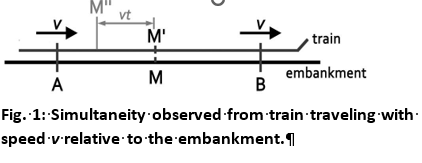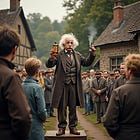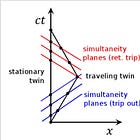The fallacy of Einstein's 'Simultaneity' axiom. Another disproof of his philosophy.
'Clocks' are synchronised and aligned at rest in motion and within an absolute frame of reference.

Saint Albert of the Einstein (arguing with himself):
“We see thus that we cannot attribute any absolute meaning to the concept of simultaneity. Rather, two events which, considered from one system of reference, are simultaneous, can, considered from a system moving in relation to the former, not be considered as simultaneous.”
“Zur Elektrodynamik bewegter Körper” (“On the Electrodynamics of Moving Bodies”), Annalen der Physik, 17, Sept. 26, 1905, p. 897.
We discuss why this contention is false. Einstein was more or less forced to his conclusions about motion and time dilation due to his ‘principle of equivalence’, which holds that there is no net difference between gravitational force and acceleration, and both effects will produce the same results. This equivalence was never proven, is patently false and is just assumed. Further, absolute time never slows, only a measured, calculated frequency of time will vary.
Thomas
‘Education’, whatever that word means, does not teach critical thinking, nor encourage Thomasian doubts about dogma. Saint Albert’s canon preaches ‘relativity’ of all variables and phenomena. Fine. I will now opt to keep lengths and time constant but change the speed of light. Everything is ‘relative’ isn’t it?
Mathematically speaking, the two solutions, where we have a variance in light speed in the second solution (with invariance in the first), are precisely equivalent. In this case, the ‘relative’ nature of Relativity comes back to haunt it and using the Saint’s own maths we can ‘prove’ that light is invariant which destroys the principle axiom of ‘relativity’. So much science.
Life is just a fantasy
Evidential proof of the aether, variant light speed, plasma, electro-magnetic energy, the real nature of redshifting, blueshifting, parallax, steller aberration, black hole disproof (future posts on this), along with hosts of other observable facts, including various inventors and discoverers, are simply ignored and rubbished. Even Newton is pushed to the side.
Though it might be hard to imagine, there is no scientific reason pace Newtonian mechanics, why a single Compton wave namely the universe, oscillating in place, would not revolve around the barycenter, or the inertial point of the universe, namely our own solar system. You won’t hear or see this discussed anywhere (a future post will offer how this could work).
Relativity’s canon is accepted by apparently intelligent people (self-described, self-identified, self-anointed), without applying even a minimum of critical thinking and common sense. Consider just a few golden nuggets of anti-reality covered in this post:
1. The Einstotle’s philosophical premise that ‘simultaneity’ can be ‘relativised’. According to this genius, 2 events cannot happen at the same time in the universe. The fat man is not running up one hill at exactly the same time someone else cycles up a nearby hill. The events are relativised and separated (more below).
2. The absurdities built into the observer-dependent multiple realities, every person living in their own ‘frame’, within their own universe, which is foreign to real ‘science’.
3. Einstein’s attempt to render space and time relative (and curved), by applying Lorentz transformations is incompatible with his own relativity principle and contradicts axiomatic propositions of Newton’s first law of motion (Brown 2001, Poincaré 1904).
4. Masses at high speeds (the nearly infinite speed of light which Einstein did not understand), contracting along their ‘length’. This is anti-reality (Redzic 2008). Objects at high speed are proven to increase their mass (the whole point of this fantasy was to explain away light interference experiment failures to find the motion of this planet, by blaming the apparatus and the inability to adjust for this contraction).1
Yet students are told to memorise Relativity and repeat back on demand. They should be trained to tear it down and build models that comport to reality.
Fallacy of Simultaneity
In his 1905 paper on Special Relativity, (STR and why it is wrong), ‘the’ Einstein approached the definition of simultaneity through the problem of clocks synchronization. He suggested setting up two clocks A and B, at different locations in a stationary frame, then to send a light ray from clock A to clock B, from where the ray is then mirrored back to clock A.
This was not an innovative idea and is based on Galileo’s experiment.
After assigning tA as the time of the start of the ray at A, tB as the time of its arrival at B and t’A as the time of the arrival of the mirrored ray at A, the Einstotle correctly concluded that the clocks A and B are synchronized, if:
tB - tA = t’A - tB.
Good Einstein. We can see this in reality.
Then he wanders down fantasy lane. He goes further and wrongly associates ‘synchronicity’ with ‘simultaneity’ by saying that, with the above thought experiment using clocks, that ‘we’ have “settled what is to be understood by synchronous stationary clocks located at different places, and have evidently obtained a definition of ‘simultaneous’ or ‘synchronous’”.
So as usual the Confusionist-Philosopher has completely obfuscated reality with his word salads.
Let us define the terms:
1-Simultaneous: Two events happen at the exact same moment, the fat man is running up a hill, and nearby, someone is cycling up another hill,
2-Simultaneity: The property or condition of events occurring at the same time, running or cycling for example,
3-Synchronicity: Making sure two or more clocks read the same time, or that events measured by those clocks align, the runner’s watch synced with the cyclist’s watch
As with most of ‘The Science’, the terms easily become confused, definitions and reality are redefined, and a borscht of mixed-up ideas concocted.
The narrative’s dogma is that within Special Relativity, what is ‘simultaneous’ for one observer is not ‘necessarily simultaneous’ for another observer. This is because of the time difference in ‘clocks’, within and between the 2 observer ‘frames of reference’ (or their synchronicity). In this theory there is no ‘universal now’ due to the merger of ‘spacetime’ negating any absolute time and reference frames.
This is 100% philosophical, mathematical claptrap. It was invented to explain away the inability to measure this planet’s supposed movement in the cosmos.
All clocks can be synchronised and aligned whether they are at rest or in motion. All activities happen within a synchronous and simultaneous absolute reference frame.
You see this in everyday appliances, vehicles and measurements.
In a war zone, 2 fast-moving fighter jets, flying at very high Mach speeds, synchronise their ‘clocks’ and use those clocks to coordinate actions and communications - even if they fly in opposite directions (in their own ‘reference frames’).
The fat man running up one hill will have his clock perfectly synchronised with that of the lithe cyclist pedaling up a second more distant hill, before during and after the 2 events.
We can measure all of the actions and outputs as ‘absolute’ events, against an ‘absolute’ frame of reference – namely Newton’s universe.
There is no ‘frame’ difference. The cyclist does not inhabit a separate universe from the jogging fat man. The jet fighters do not fly in their own dimensions. That is anti-science.
Consider:
· The outcome of a synchronisation procedure is independent of the distance between the clocks,
· If clock B moves relative to clock A (i.e. when it is in another frame) the calculation is still absolute,
· A stationary and a moving clock can equally be synchronised with each other (even using Einstein’s procedure),
· Ergo, heretofore, one must conclude that despite Einstein’s claim, synchronicity is definitely not frame-dependent
False prophet with false claims
Einstein brought up the problem of simultaneity to substantiate his claim that "every [...] coordinate system has its own particular time." To demonstrate his concept of ‘relative simultaneity’, he proposed yet another thought experiment:
M=Point or location, V = Train velocity, A & B = distance points (start and finish for eg)
A train is moving down the tracks and there are lightning strikes on the embankment at points A and B.
· Single lightning strikes at points A and B on the embankment at the same time as a train went by (according to a clock registering the embankment's time)
· Light is reflected from both points A and B towards the point M, which is halfway on the A – B distance
· An observer standing on the embankment at location M registers the light signals arriving from A and from B at the same time
· The observer concludes that lighting strikes at A and at B occurred simultaneously
This seems obvious to a normal person. So far so good! But as usual, in order to justify his own fantasy-world, the Einstein goes further. He questions what happens on the moving train. He asks: "Are two events (e.g. the two strikes of lightning at points A and B) which are simultaneous with reference to the railway embankment also simultaneous relatively to the train?.. We shall show directly that the answer must be in the negative..."
Einstein, playing the role of an insane observer, declares that since M' on the train, which is aligned with M at the very instant of the lighting strike, but moves with speed v (away from M) during the time while light travels from A (or B) towards M (or M'), the observer standing at M' (on the train) will not see the two light signals from A and from B arriving simultaneously. He thereby concludes that, "Events which are simultaneous with reference to the embankment are not simultaneous with respect to the train, and vice versa."
As usual, ‘The Einstein’ is wrong. The greatest ‘scientist evah’ somehow failed to understand that there is a well-defined location on the train, at which the observer should be able to observe simultaneity.
1. Let t be the time required for light to travel from A to M
2. It follows that an observer standing on the train at the vt distance from M towards A (at location M) detects light from A and from B arriving at the same time
3. An observer standing on the train at location M'' would also conclude that the events at A and B did occur simultaneously (Mészáros, 2021)
Thanks for playing Einstein.
As mentioned above, ‘simultaneity’ is never frame-dependent. A successful detection of simultaneity in this example is simply a methodological problem, requiring some common sense about the relative speed of the moving frame. Einstein’s claim that "every [...] coordinate system has its own particular time", is unsupported by his erroneous ‘relative simultaneity’ argument, which is a false reasoning to render time relative. His example and arguments do nothing to disprove an absolute or real simultaneity.
Bottom Line
We have disproven Einstein’s declaration that simultaneity is relative. This is supported by Newton’s first law of motion, which asserts axiomatic propositions about the nature of motion.
Newton clearly defined inertia, and postulated the relativity of (uniform) motion, from which it directly follows that any one of the inertial frames can equally be considered as a rest (or reference) frame, while another as a moving frame.
Einstein’s STR is incompatible with these axiomatic concepts of Newton’s first law of motion and therefore with also the relativity principle itself (although Einstein frequently claimed otherwise).
We have shown that Einstein’s theory necessarily leads to absurdities, such as observer-dependence and multiple realities, which, of course, should not be accepted by science. Taking these together, one should conclude that there is no scientifically acceptable reason to render space and time relative.
This means that Einstein’s general theory of relativity is not scientific, given we have no reason and no proof to assume the curvature of space and time.
All hail.
====
1Spot the Tautology → Einstein 1905 STR: “[…] an analysis of the physical conceptions of time and space, it became evident that […] by systematically holding fast to both these laws [i.e. the relativity principle and the invariance of the speed of light] a logically rigid theory [i.e. the STR] could be arrived at…..every [...] coordinate system has its own particular time"
1. Brown, H.R.: The origin of length contraction: The FitzGerald-Lorentz deformation hypothesis, Am. J. Phys. 69: 1044 (2001)
2. Einstein, A.: On the electrodynamics of moving bodies (English translation, ed. John Walker), Ann. der Physik. 17: 891 (1905) or Special Relativity
3. Einstein, A.: Relativity: The Special and the General Theory, Reprint of 1920 translation by Robert W. Lawson ed. (2001)
4. Redzic, D.: Towards disentangling the meaning of relativistic length contraction, Eur. J. Phys. 29: 191 (2008)
5. Mészáros, L. G.: Special relativity as an account for a “special kind” of optical illusion, Phys. Essays 34: 367 (2021)
6. Poincaré, H.: The Principles of Mathematical Physics, Congress of arts and science, universal exposition, St. Louis, Boston and New York: Houghton, Mifflin and Company. pp. 604 (1904)






